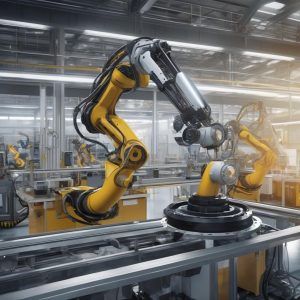How Robotics Is Changing Manufacturing

How Robotics Is Changing Manufacturing.
Meta Description: Discover how robotics is revolutionizing manufacturing, boosting efficiency, productivity, and transforming the industry landscape.
Introduction
In the modern manufacturing landscape, robotics plays a pivotal role in driving revolutionary changes. As technology advances at an unprecedented pace, industrial robots are becoming increasingly sophisticated and integral to manufacturing processes around the world. For tier 1 countries like the United States, Canada, and Australia, embracing robotics in manufacturing has become crucial to maintaining a competitive edge. This article explores how robotics is transforming manufacturing, the benefits it offers, and the potential drawbacks it presents.
The Rise of Robotics in Manufacturing
The incorporation of robotics in manufacturing has evolved significantly since the first industrial robots were introduced in the late 20th century. Initially used for simple, repetitive tasks, today’s robots possess the ability to perform highly complex operations with precision and agility. The driving force behind this evolution includes advancements in artificial intelligence (AI), machine learning, and sensor technology.
READ ALSO: Understanding Deep Learning vs. Machine Learning.
Advanced Automation
Modern robots are equipped with sophisticated sensors and algorithms that allow them to learn and adapt to varying conditions. This has transformed automated processes in industries ranging from automotive to electronics. By efficiently performing tasks that once required human intervention, robotics has minimized errors, increased production speed, and reduced manufacturing costs.
Image Alt Tag: Advanced industrial robot arm in a manufacturing facility
Benefits of Robotics in Manufacturing
Increased Efficiency and Productivity

Robots work at higher speeds and precision than human workers, resulting in faster production times. They are capable of operating 24/7 without fatigue, significantly boosting output and efficiency. In sectors like automotive manufacturing, this has led to a reduction in time-to-market for new vehicles.
Enhanced Quality Control
Robotics enables consistent quality control by ensuring uniformity and precision in production. For example, robots can detect minute defects in products during the manufacturing process, minimizing waste and ensuring products meet strict quality standards.
Cost Reduction
Although the initial investment in robotics can be high, the long-term savings are substantial. Reduced labor costs, minimized material waste, and improved processes contribute to cost-efficiency and higher profit margins for manufacturers.
Image Alt Tag: Cost-effective robotic assembly line in a factory setting
Safety Improvements
Robots can perform hazardous tasks that pose risks to human workers, reducing accidents and occupational hazards. In environments with high temperatures, toxic substances, or heavy machinery, robotics enhances worker safety by taking on dangerous duties.
Challenges and Considerations
Despite its many advantages, the integration of robotics in manufacturing presents several challenges:
High Initial Investment
The cost of acquiring advanced robotic systems can be prohibitive for some manufacturers, especially small to mid-sized enterprises. However, leasing options and government incentives can help mitigate these costs.
Job Displacement
The automation of manual tasks has led to concerns about job displacement. While robotics creates new job opportunities in programming, maintenance, and oversight, it also necessitates workforce retraining and upskilling to prevent unemployment.
Complex Implementation
Implementing robotics in a manufacturing setting requires technical expertise and thorough planning. Companies must carefully assess their production needs and capabilities to ensure a successful integration that aligns with their business goals.
Future Trends in Robotics within Manufacturing
The future of robotics in manufacturing is set to experience several transformative trends:
Collaborative Robots (Cobots)
Cobots are designed to work alongside humans, enhancing productivity while maintaining flexibility. They can be easily integrated into existing workflows, offering a cost-effective solution for small and medium-sized manufacturers.
AI-Powered Robotics
The incorporation of AI in robotics allows machines to make decisions, learn from experiences, and optimize processes on their own. This results in further gains in efficiency and quality.
Sustainability Initiatives
Robotics can contribute to sustainable manufacturing practices by optimizing resource use and minimizing waste. Enhanced precision and automation lead to energy efficiency and reduced environmental impact.
Conclusion
Robotics is undeniably reshaping the manufacturing industry, offering significant benefits in terms of efficiency, quality, and safety. However, it presents challenges that manufacturers must address to fully capitalize on its potential. As technology continues to advance, the integration of robotics will become more seamless, further revolutionizing the way industries produce goods and services.





